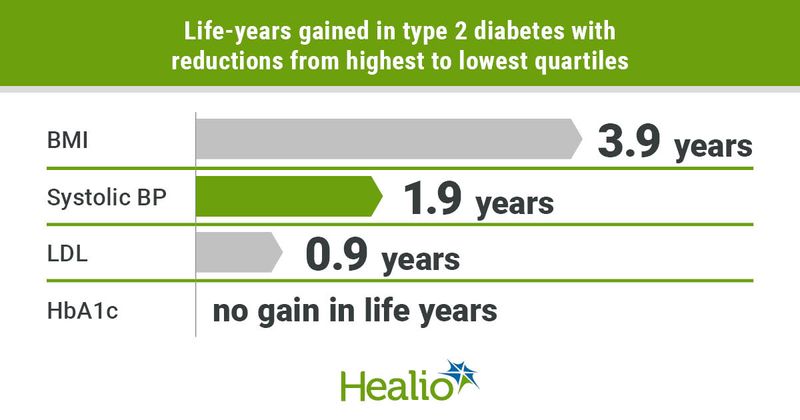Achieving biomarker goals extends life expectancy in type 2 diabetes
People with type 2 diabetes who achieved recommended targets for HbA1c, systolic blood pressure, LDL cholesterol and BMI had increased life expectancy, although the size of increase differed among the biomarkers, concluded recent research.
For the study, Hui Shao, MD, PhD, assistant professor in the department of pharmaceutical outcomes and policy at the University of Florida College of Pharmacy, and colleagues used a decision analytical model to measure potential gains in life expectancy associated with lowering HbA1c, systolic BP, LDL cholesterol and BMI toward optimal levels in a representative population of U.S. adults with type 2 diabetes.

Researchers grouped the study population into quartiles based on HbA1c, systolic BP, LDL cholesterol and BMI. The main outcome measure was life expectancy. The study included data from 421 adults (mean age, 65.6 years; 46% women) from the 2015-2016 National Health and Nutrition Examination Survey.

Results revealed that those with lower BMI had increases in life-years compared with a mean BMI of 41.4 kg/m2, or the fourth quartile: 24.3 kg/m2 BMI (first quartile), 3.9 years; 28.6 kg/m2 BMI (second quartile), 2.9 years; and 33 kg/m2 BMI (third quartile), 2 years. Similarly, compared with a systolic BP of 160.4 mm Hg, those with lower systolic BP levels had gains in life expectancy: 114.1 mm Hg, 1.9 years; 128.2 mm Hg, 1.5 years; and 139.1 mm Hg, 1.1 years.
Furthermore, compared with an LDL cholesterol of 146.2 mg/dL, lower LDL cholesterol levels yielded life expectancy gains of 0.9 years for 59 mg/dL, 0.7 years for 84 mg/dL and 0.5 years for 107 mg/dL.
In other data, lowering HbA1c from 9.9% to 7.7%, or from fourth quartile to third, resulted in a gain of 3.4 years in life expectancy. In contrast, a further reduction to the second quartile (6.8%) yielded only a 0.5-year gain in life expectancy, and from second to first (5.9%) quartiles, there was no life expectancy benefit.
“Overall, reducing HbA1c from the fourth quartile to the first is associated with [a life expectancy] gain of 3.8 years,” Shao and colleagues wrote.
“We estimated the potential gains in life expectancy associated with improvement in biomarkers, finding that improving each of the four biomarkers toward the recommended levels was associated with gains in life expectancy, although the pattern and magnitude differed between them and according to patients’ characteristics (eg, age). Our findings can be used by clinicians and patients in selecting optimal treatment goals, to motivate patients in achieving them, and to measure potential health benefits for interventions and programs to improve diabetes care in the U.S.,” the researchers concluded.
